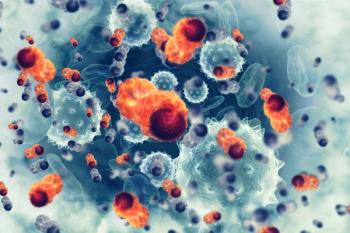
Oncology NEWS International
- Oncology NEWS International Vol 17 No 11
- Volume 17
- Issue 11
Folate polymorphisms underlie neuropsychological impairment in ALL survivors
NIAGARA-ON-THE-LAKE, Canada- Previous studies have shown that 20% to 40% of survivors of childhood acute lymphoblastic leukemia will have some form of neuropsychological impairment. “However, we do not fully understand why some children are so strongly affected by therapy, and would like to develop a model to determine which children are most at risk for these negative late effects,” said Kala Y. Kamdar, MD, of the department of pediatric hematology/oncology, Baylor College of Medicine, Houston.
ABSTRACT: Methotrexate chemotherapy, which leads to folate depletion, may contribute to neuropsychological impairment.
NIAGARA-ON-THE-LAKE, Canada- Previous studies have shown that 20% to 40% of survivors of childhood acute lymphoblastic leukemia will have some form of neuropsychological impairment. “However, we do not fully understand why some children are so strongly affected by therapy, and would like to develop a model to determine which children are most at risk for these negative late effects,” said Kala Y. Kamdar, MD, of the department of pediatric hematology/oncology, Baylor College of Medicine, Houston.
Methotrexate chemotherapy, which leads to folate depletion, is believed to be a major contributor to neuropsychological impairment in this population.
“We know that adequate folate is critical for normal central nervous system development. Therefore, we hypothesized that folate pathway polymorphisms will explain why some children develop neuropsychological impairment aft er childhood ALL therapy and others do not (see Figure 1),” Dr. Kamdar said at the 2008 International Conference on the Long Term Complications of Treatment of Children and Adolescents for Cancer. The meeting was sponsored by Roswell Park Cancer Institute and the National Cancer Institute.
Dr. Kamdar’s team recruited 72 childhood ALL survivors from the Texas Children’s Cancer Center who had completed their therapy. The median time off -therapy was 4.4 years. Participants were excluded if they were less than a year old at diagnosis and/or their medical history included cranial irradiation or central nervous system involvement.
All were tested for six folate pathway polymorphisms. Participants were screened for neuropsychological impairment through a variety of tests and parental interviews.
In this population of survivors, 21.9% were identified as having attention disorder. The team also performed genotyping of selected folate polymorphisms (see Table).
Results showed a greater than sevenfold increase in attention disorder in survivors with the MTHFR 1298AC/CC genotypes, as compared to the MTHFR 1298 AA genotype.
The MS 2756A>G polymorphism was also associated with defi cits in attention and information-processing speed, and the TS 5´UTR tandem repeat showed a borderline association with attention disorder.
“As we expected, the cumulative dose of systemic methotrexate also correlated with neuropsychological impairment. We did not see any correlation with gender, ethnicity, age at diagnosis, or intrathecal chemotherapy,” Dr. Kamdar said (see Figure 2).
High-risk intervention
The team plans to continue enrolling patients in this study and to genotype other functional polymorphisms in the folate pathway.
They are also planning to explore the associations between folate pathway polymorphisms and neuropsychological impairment in a noncancer population to determine whether the observed effect is truly related to cancer therapies.
The ultimate objective of the team is to implement interventions in high-risk patients to minimize long-term neuropsychological impairment.
For example, if genetic screening identifi es a patient at risk, a behavioral therapy program could be instituted soon after leukemia diagnosis.
In the long term, continued pharmacogenetic studies may lead to tailoring of ALL chemotherapy dosing to minimize both acute and long-term toxicities.
Commentary
Daniel Green, MD, of the department of epidemiology and cancer control at St. Jude Children’s Research Hospital, Memphis, stressed the need “to confi rm the association between polymorphisms and impairment.”
The polymorphisms “could be used to identify patients at high risk who perhaps should receive reduced doses of methotrexate,” Dr. Green explained. “But any discussion of changing the standard therapy will be a difficult risk benefit judgment.”
Articles in this issue
about 17 years ago
Elaine Jaffe: At the forefront of clinical lymphoma biologyabout 17 years ago
Clinical trials struggle to recruit, retain patientsabout 17 years ago
Global financial woes threaten new UK radiotherapy centersabout 17 years ago
UK health service urges drug cost cutsabout 17 years ago
Birth length of at least 50 cm may bump up breast ca riskabout 17 years ago
Obama, NCCN win endorsements in online poll surveysabout 17 years ago
Colonoscopy proves cost-effective in young patientsabout 17 years ago
Philips Healthcare extends contract for image-guided oncologyabout 17 years ago
US Oncology teams with RTOG to boost trial enrollmentNewsletter
Stay up to date on recent advances in the multidisciplinary approach to cancer.
















































































